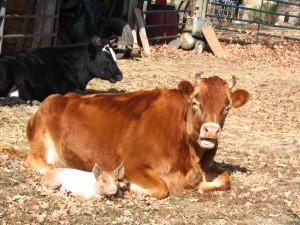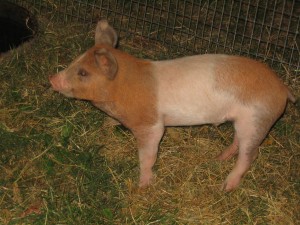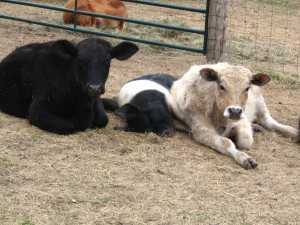The first notice of my land came in 1835, when surveyors passed along the North line of my South forty, which is a section line. They noted good timber on the ridges and actually saw some small fields along Meadow Creek near it’s mouth at the Middle Fork of the Little Red River, just a couple miles SW of here.
This particular parcel was homesteaded by Earnest Bilke in 1916. He cleared a field and built a house on this land. Several years later he traded land (a common thing in those days) with a man called Daddy Richardson. Mr. Richardson built a new house and farmed this place for a number of years, clearing about five acres on the ridge (where my pine woods is today), growing cotton, corn, and sorghum. When I bought this place there was still a rock foundation and chimney where the cooking pan for molasses had been set up. Richardson farmed until 1936, then left for California without even trying to sell it. It went back to the state for taxes. In 1963 it was purchased for said taxes, $30.00, by a land company made up of two local ranchers and two Mountain View businessmen.
In the Spring of 1973 I borrowed a horse from a friend and rode across a one-hundred acre piece of land that was for sale for $100 per acre. It had been logged recently and looked very dry, but I kept riding down an old unused logging road until the timber got better and I came upon a pine grove, which I knew was evidence of an old field. I figured that if there had been a field, then someone must have lived here, and if someone had lived here then there must be water. I rode the horse down past where the pond now stands, and found evidence of a year-round spring. I then rode over the ridge to where it drops off into Bear Pen Hollow. Since the leaves were on the trees and the whole place was like a jungle, I had to shinny up a tree to see the great view to the West. Then and there I decided that this was the land for me. I rode back to the owner of the 100 acre parcel and found out that the place with the spring on it belonged to Robert Linville. He and his land partners had recently sold some land to some hippies, and they had a feeling that land was about to start selling. After some haggling they agreed to sell me this 40 for $145.00 per acre, which was on the high side for unimproved land at that time.
A name seemed to be in order for this place, so I chose Bear Pen Farm, since about 15 acres of my land lay on the side of this steep and rugged holler.
That Fall I started to build a six-sided log “Hogan”, twenty feet in diameter, as a temporary structure until I could build a bigger house. This would prove to be such a comfortable home that it would be seventeen years before the bigger house would be finished.
Tag Archives: free range
PIGS
I guess we started raising pigs about thirty years ago. I figured I could raise two pigs, sell one to pay for the cost of pigs and feed, and butcher the other one.
At first I started doing it the same way I had always seen it done. I fenced in a pretty good size hog lot out of woven wire and built a wooden pig house so they could get out of the weather. We would feed the pigs wheat bran, corn chops, garden and table scraps and lots of skim milk from our cow. When the pigs reached around 250 lbs I would sell one and get set up for butchering. I used the same method that has been done in the Ozarks for years. I learned it from watching my neighbor, Lonnie Lee butcher his hogs. We built a fire under a 55-gallon barrel full of water, and set up a pulley and rope system to raise the hog and lower it into the water. When the water was almost to a boil, I would shoot the hog between the eyes with a .22 rifle and quickly put a chain loop around it’s leg, pull it off the ground with my truck and sever the aorta with a butcher knife to get a good bleed. Then we would dip the whole hog into the barrel to cause the hair to slip, lay the hog on a home-made table, and scrape all the hair off with knives. When the hair was off, I would hang it, remove the viscera and internal organs, saw the carcass in half from tail to shoulders, and leave it hanging overnight to chill. I always try to butcher on a night when it will freeze. Not only is it important to cool the meat quickly, it is much easier to cut up meat when it is partially frozen.
For several years we tried the traditional method of preserving most of our meat through salting and smoking. This involves injecting the meat with brine, smothering the meat with salt, then after a time, smoking the heck out of it. You wind up with hams and shoulders that will keep without being frozen, but meat that is impossible to eat without soaking in water to remove some of the salt. It didn’t take too many years of this to figure out that a freezer would be a good thing. We bought a used freezer and paid a neighbor to keep it at her house (she had electricity). We continued to scald and scrape our hogs for a few more years until I figured out that the only reason to keep the skin on the hog was as a way of preserving the meat. Then we started skinning rather than scraping. No more smoky fires and dangerous scalding water. With a sharp skinning knife two of us can snatch the hide off a hog in about half an hour.
It only took a few years, though, to see that keeping hogs in a pen is an environmental disaster. I could see that they were wearing a hole in the ground from their constant rooting and wallowing. Not only that, but it was very expensive to buy feed, which of course they needed every day. That is when I discovered a new method of raising hogs. Now when we buy a little feeder pig we put it in a temporary pen in the same pasture with whatever
calves I have on hand at the time. The calves are usually fascinated by the pig and spend a lot of time communing with it through the fence. It only takes a few days for the animals to bond—then I can release the pig and it spends the rest of it’s happy life roaming the farm with it’s bovine pals, grazing on grass and finding acorns and all sorts of goodies in the woods. Even though it can fit under the barbed-wire fence that is the boundary of our farm, the pig will NEVER get out of sight of the calves, so there is no danger of it finding it’s way to our nearest neighbor, a half-mile away.
Since I have been teaching guitar and fiddle at the local school one day a week, I haven’t had to buy ANY feed. One day’s lunch tray scrapings from 130 students is enough to feed a pasture-raised pig for a week! Now when I see the crater down in the woods that marks the spot where the hog pen used to be I just shake my head. We live and learn…………….



